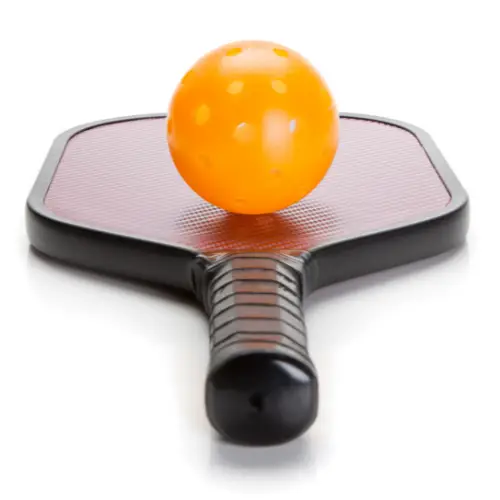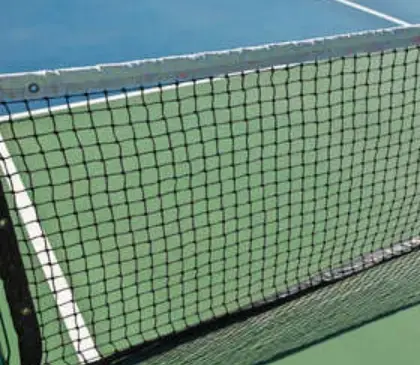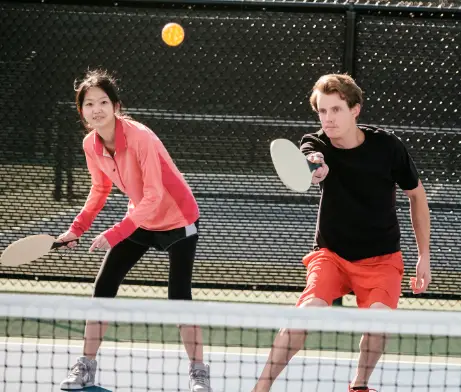Pickleball is a popular racquet sport that combines elements of tennis, badminton, and ping-pong. It’s a fun, low-impact activity that can be enjoyed by people of all ages and skill levels. If you’re looking to improve your pickleball skills, but don’t have anyone to play with, don’t worry! There are still plenty of ways to practice on your own. In this article, we’ll give you some tips and ideas for how to practice pickleball alone, so you can hone your skills and become a better player. Whether you’re just starting out or looking to take your game to the next level, these solo practice techniques will help you get there.
Can You Play Pickleball By Yourself?
Sometimes it’s impossible to reach the court. Sometimes there aren’t any other players at the court to practice with, or your family isn’t interested in participating.
Or maybe you just want to play pickleball by yourself to advance your skills more quickly.
Even though you can’t play pickleball by yourself, that would raise the bar for pickleball singles significantly! – You can surely enhance your pickleball serves and shots without the help of anyone else.
Here’s how to play pickleball by yourself, whether you’re going to the court alone or want to train at home.
How To Practice Pickleball Alone: Step by Step
- Set up the pickleball court in a designated area. If you do not have access to a traditional pickleball court, you can use a flat surface such as a driveway or tennis court to play on.
- Gather the necessary equipment. This includes pickleball, paddles, and a net (if you have access to one). If you do not have a net, you can practice serving and hit against a wall or other flat surface.
- Warm up before starting your practice session. This could include stretching, jogging, or practicing some basic strokes to get your muscles warmed up and ready to play.
- Start practicing your serves. Work on hitting the ball with a variety of spins and aiming for different areas of the court.
- Practice your returns by hitting the ball back to the spot where you served it. Try to hit it with a consistent and controlled shot.
- Practice your volleys by hitting the ball back and forth over the net. Focus on getting a good, solid hit and keeping the ball in play.
- Practice your dinks by hitting the ball softly and with control over the net. This shot is used to keep your opponent off balance and is a key part of a successful pickleball game.
- Take breaks as needed to rest and hydrate. Pickleball can be a physically demanding sport, so it is important to take care of your body during your practice sessions.
- Continue practicing and fine-tuning your skills until you feel confident and ready to play with others. Remember to always stay safe and follow proper guidelines for playing alone, such as not hitting the ball too hard or too close to other people or structures.
What Are Some Solo Pickleball Drills?
The pickleball exercises listed below can all be performed by one person. We’ve divided them into solo pickleball drills you can practice on the court and some that you can do anywhere—even at home—because we realize you might be constrained by the space you have.
There are countless pickleball drills you can practice alone if you have access to a pickleball court. And for the majority of these solo drills, you could utilize a tennis court if you don’t have a pickleball court to practice on.
- Practice your serve
It makes sense to practice your serve as much as you can since your pickleball team can only score when you are serving. Thankfully, doing something by yourself is not too difficult!
One of the finest methods to boost your self-assurance and accuracy on the court is to practice your pickleball serve alone. If you’re new to the sport, you might want to work on just precisely hitting the ball. This can be accomplished by striking a target or aiming for a specific spot on the line if you have something you can place down.
If you’ve played pickleball for some time, this is a wonderful opportunity to work on your depth. In addition to shooting for a target, try to accelerate the ball’s descent. Even though playing solo pickleball may not be as enjoyable as playing the actual game, practicing alone will help you improve.
- Get more comfortable on the court
It’s similar to learning to play an instrument to learn how to play pickleball well. There is a lot to consider when you first start, and it seems like everything is happening slowly. But as you get better, you start acting without even thinking about it.
Anyone who has played pickleball for a while will agree with this. The number of things that need to be done during a game, such as observing your opponent, positioning yourself correctly, using the perfect shot, being aware of your partner’s location, etc., may have first overwhelmed you. But when you get better, these things come naturally.
Simply practicing to gain a feel for things without the pressure of a game is one of the finest methods to speed up the process. You may concentrate on reaching Mozart levels on the other things by removing the majority of the things you need to think about, such as the opposing team, your partner, and the sort of shot coming your way. Take advantage of your alone time to go around the court and estimate how distant the kitchen is. You won’t again have to be concerned about unintentionally entering the non-volley zone again!
- Advanced solo dinking practice
Even for advanced players, hitting the courts alone can be advantageous. Even though dinking is one of the most crucial pickleball moves, you don’t necessarily need a drill partner to perfect it. Simply run to the opposite side and dink the ball back while standing at the end of the net.
This one will undoubtedly make you sweat, but it will also prove that pickleball can be a terrific kind of fitness. While novice pickleball players can practice this dink drill alone, moderate and advanced players probably benefit more from it.
- Volley accuracy drill
How frequently does the ball not land where you expect it to? if you’re anything like us, constantly! Even while nobody can always direct the ball exactly where they want it to go, this solitary exercise can help you become more accurate.
Simply use tape to mark a square or location on the wall. Then, while positioned just outside the kitchen, try to strike the target as many times as you can. You might be surprised at how rapidly your accuracy increases after some practice! Don’t forget to roam around and shoot from various angles. Once your accuracy improves, feel free to shift the target.
- Forehand/backhand volley
Pickleball volley requires strong reflexes and reaction times to improve. Forehand and backhand shots must be delivered precisely if you want to get better at pickleball, and that’s what we’ll do here.
Standing seven feet away from a wall is equivalent to standing one kitchen size away. When it’s your turn to serve in a genuine pickleball game, serve to the wall with a forehand shot when you’re ready to start. Once the ball has rebounded, use a backhand shot to return it to the wall. till you miss, keep going.
- Legwork Practice
While the majority of pickleball practice concentrates on your shots, serves, and other arm work, it’s crucial to remember your legs as well. Pickleball workouts When you’re playing pickleball by yourself, spend some time working on your leg movements to prepare for when you’re back on the court.
Although practicing dinking alone is difficult, you can practice the lateral motions in the non-volley zone. Don’t undervalue the value of dinking practice when you start to develop as a pickleball player. By working on your lateral motions, which is a pickleball activity you can do anywhere, you may enhance your kitchen play.
- Shadow Swing
When you swing the pickleball paddle without making contact, you are executing a shadow swing. You may improve your paddle form by doing this, which will help you control the ball more effectively on the court.
Conclusion
In conclusion, practicing pickleball alone can be a challenging but rewarding experience. By setting up a solo drill or using a ball machine, players can work on their skills and improve their game without the need for a partner. It is important to have a clear goal in mind and to vary the drills and exercises to keep things interesting and challenging. With dedication and consistent practice, players can make significant progress in their pickleball skills even when practicing alone.







